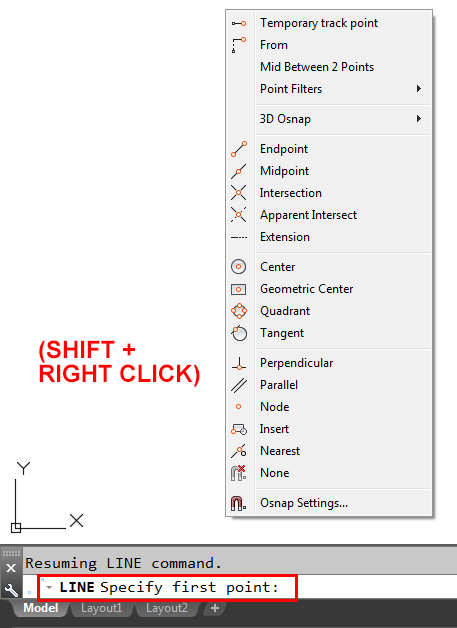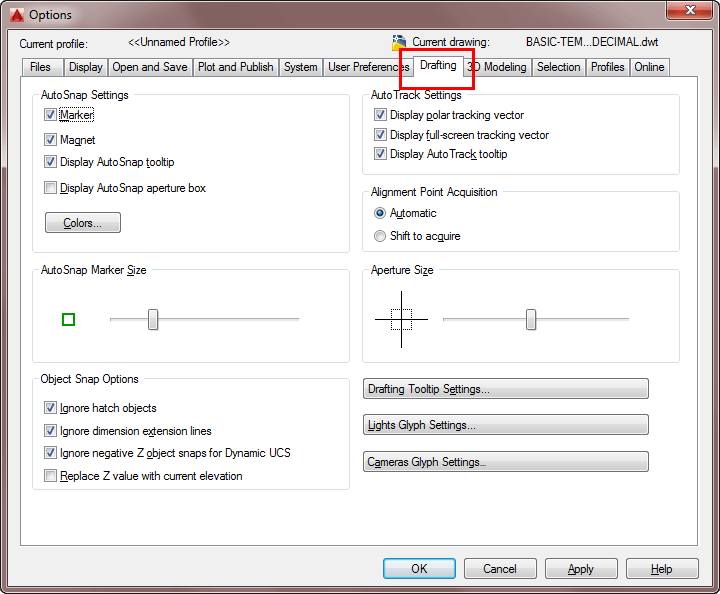Object Snaps in AutoCAD
- Lesson 4-1AUTOCAD TEMPLATE FILES
- Lesson 4-2USING OSNAPS IN AUTOCAD
- Lesson 4-3LINETYPES AND LINETYPE SCALE
- Lesson 4-4AUTOCAD FILE FORMATS
- Lesson 4-5GRIP EDITING / DIVIDE COMMAND
- Lesson 4-6AUTOCAD'S INQUIRY TOOLS
- Lesson 4-7XREF'S (EXTERNAL REFERENCES)
- Lesson 4-8SYSTEM VARIABLES IN AUTOCAD
- Lesson 4-9TABLES
- Lesson 4-10CREATING AND PUBLISHING SET SHEETS
- Lesson 4-11MODIFYING AND CREATING DIMENSIONS
- Lesson 4-11aDIFFERENT TYPES OF DIMENSIONS
- Lesson 4-12INTRODUCTION TO CUSTOMIZING AUTOCAD
- QUIZ FOR LEVEL 4 - 67 QUESTIONS
Topics covered in this Lesson:
Using Object Snaps (Osnaps) in AutoCAD

Object snaps (Osnaps) are one of the handiest tools in AutoCAD. Without them, you would have a lot of trouble doing even the simplest dimension accurately. Before discussing how they are used, first think about what they are. Their name, "object snaps" means that they allow you to snap to objects, or more precisely, you snap to specific parts of an object. A line for example has 3 points that you can snap to: a midpoint and two endpoints. A circle has 5 points: a center and 4 quadrants. To use Osnaps effectively, you must know what points an object has that you are able to snap to.
There are also some Osnaps that are not particular points. These allow you to snap to (sometimes) arbitrary points along an object. These would include nearest, tangent, perpendicular and to some extent, intersection.
There are two different ways of working with Osnaps; in running mode or invoking them individually as required. Running Osnaps mean that certain ones are turned on and running in the background. This means that they are available when needed in the middle of a command. Generally, you'll leave some running that you use commonly like endpoint, midpoint and center.
Sometimes you may need one Osnap that isn't one you have selected in running mode. In this case you can turn it on for one-time use. There are a few ways of doing this: you can select the icon for the Osnap you need, you can type in the 3 letter shortcut, or you can bring up the Osnap dialog box and turn it on ('OS), or even shift+right-click and pick from the menu. I recommend learning the 3 letter shortcuts and typing them in when required. This is generally the fastest way to get your Osnap on, plus it doesn't leave it on if you don't need it afterwards. Having the icons up your screen works, but takes up valuable screen area. Try each method and see which one works best for you.
In most cases you do not want to turn on all the osnaps while drawing as you could accidentally snap to a point you don't want. For example, the endpoint and a perpendicular point could be very close - so you need to be careful when using perpendicular.
Below is the Osnap dialog (OS) box followed by a detailed listing of how each one is used.

Here is a table which lists all available Osnaps in AutoCAD:
| ICON | SHORTCUT | SETTING |
|---|---|---|
| TT | TEMPORARY TRACK POINT | |
| FROM | SNAP FROM | |
| END | END | |
| MID | MID | |
| EXT | EXTENTION | |
| CEN | CENTER | |
| CE | GEOMETRIC CENTER | |
| NOD | NODE | |
| QUA | QUADRANT | |
| INT | INTERSECTION | |
| INS | INSERTION POINT | |
| PER | PERPENDICULAR | |
| TAN | TANGENT | |
| NEA | NEAREST | |
| APP | APPARENT INTERSECTION | |
| NON | NONE | |
| OS | OSNAP SETTINGS | |
| - | M2P | Middle of 2 points |
To see the icons, Shift+Right-Click while in a command like Line where an Osnap would be used.

The 3 letter shortcut is shown in bold in the table above. Notice that it is the first 3 letters of each Osnap.
Also note the Osnap symbol beside each setting in the image of the dialog box above. These will be visible on your screen as the osnap becomes active.
LISTING OF OSNAPS MODES
 |
OSNAP TRACKING - While not really an Object Snap, this option allows you to pick any point on the screen and track from there. This point can be on an object or not. Toggle on and off with F11. |
 |
FROM - This option allows you to select an Osnap and use it as a reference point. Very similar to Temporary Tracking. |
 |
ENDPOINT – This snap is used to get to the exact endpoint of a line, arc or other object that has a definite ending to it. This should be used for joining lines, and dimensioning. In general, you would want this on as a running Osnap in your drawing. The endpoint Osnap is indicated by a small square. |
 |
MIDPOINT – This is used to find the exact middle of any object that has a beginning and an end. All lines and arcs have a midpoint. (Circle have a center, not a midpoint.) This is also a good Osnap to have in running mode. The midpoint Osnap is indicated by a small triangle. |
 |
CENTER – The center Osnap is used to find the exact center of circles, arc and ellipses. This is also a good Osnap to leave in running mode. To pick the center point, you have to select the object itself, and not an area in the middle of the object. The center Osnap is indicated by a small circle. |

|
GEOMETRIC CENTER – This is a new Osnap that is really handy. Use it when you need to snap to the 'geometric' center of a rectangle rather than trying to find the two midpoints. Works on closed polylines, rectangles, splines |
 |
NODE – Nodes are points. The are created using the point command. They are also created when an object is divided. A node Osnap is indicated by a circle with angled crosshairs in side. |
 |
QUADRANT – Quadrants are the ‘corners' of circles and ellipses. Arcs can also have quadrants. The quadrant Osnap is indicated by a diamond. The are four quadrants on every circle. |
 |
INTERSECTION – The intersection Osnap appears wherever two objects cross. If you select one object you'll see a cross with three dots indicating that you have to select a second object to find an intersection. Pick on the second object and AutoCAD will find the intersection for you. This is handy when you have a lot of lines in the same area. An ‘X' indicates the intersection Osnap. |
 |
INSERTION – The insertion Osnap will snap to the insertion of points of objects such as blocks, text and attributes. Each object will be different depending on how it was created. The insertion Osnap is shown as two small, offset squares. |
 |
PERPENDICULAR – The perpendicular Osnap is used to draw a line from one point to another point at a right angle (90degrees) to an object. This Osnap can save you having to trim or extend afterwards. If you use the perpendicular Osnap for starting a line, you will get the indicator with 3 dots telling you that the next point is needed to establish the starting point. The perpendicular Osnap is indicated by a square with two extending lines. |
 |
TANGENT – Tangent Osnaps are used on circles, arcs, ellipses and splines. A line tangent to an arc gives you a smooth line off the curve. If you select the tangent Osnap as the first point, your indicator will have three dots following it. This means that the tangential point can not be established until the second point is given. The tangent Osnap is shown as a circle with a line across the top of it. |
 |
NEAREST – The nearest Osnap does just as the name implies: it will find the closest point on an object relative to where you started. This is handy for measuring distance and drawing quick lines, but can lead to erroneous results when dimensioning or drawing. This Osnap should rarely be used in running mode, and never for dimensioning. The nearest Osnap is indicated by a triangular hourglass. |
 |
APPARENT INTERSECTION – The Apparent Intersection Osnap is used when two objects appear to intersect on the screen, but do not truly intersect in 3-D space. It also works when any two objects do not intersect, but you need to find the point where they would. This Osnap will also find the true intersection of two crossing objects. This Osnaps has different indicators depending on which mode is needed at the time. |
NONE – This command is used to turn off any Osnaps that may be on in running mode. You can also disable your Osnaps by hitting the F3 key, which would be a faster way of doing this.
Added In AutoCAD 2005, there is a new Osnap "Midpoint Between 2 objects" - it's not in the Osnap dialog box, but can be invoked when needed by typing "MTP" or "M2P" or using the shift+right-click option.
Command: L LINE Specify first point: MTP
First point of mid: <PICK> Second point of mid: <PICK>
Specify next point or [Undo]: (Select point or enter to end)
OTHER NOTES ABOUT OSNAPS:
Osnaps are only available when you are currently in a command.
Toggle Osnaps on and off by using the F3 key. If you do not have any Osnaps on in running mode, the F3 key will invoke the Osnap dialog box. Toggle Object Snap Tracking with F11.
Get into the habit of working with the same 2 or 3 Osnaps in running mode whenever you are drawing. The more consistent you are, the easier it is to keep track off while working.
When dimensioning, you must be VERY careful where you are snapping to. Make sure that you are not using the nearest, perpendicular or intersection Osnaps unless you specifically require them. Below is an image that shows a common mistake of dimensioning to another dimension line and not the object. Often you will catch this if your measurement is an odd number (should be 11 in the example below).

If you have a lot of objects in one area, and need a particular Osnap, use the TAB key to cycle through all available Osnaps in the area. As you hit the TAB key, you will see that the Osnap location changes and AutoCAD highlights the object you would snap to.
Zoom in when in doubt. Make sure that you are snapping where you need to. Snapping to the wrong part can cause catastrophic events.
If you want to invoke the Osnap dialog box while in the middle of a command, type in ‘OS at the command prompt. You can then make your changes and then continue with the command.
CHANGING THE OSNAP'S APPEARANCE
If you want to change the appearance of the Osnap indicators, such as size or color, bring up the Osnap dialog box and pick on the Options button on the Osnap Dialog box).

On the left side of the dialog box, you can set the 'look' of the Osnaps when you are using them.
The Marker, Magnet and Snap Tip should be left on. Marker shows the active osnap. Magnet 'snaps' you into position when you are near. The Snap Tip is a small text box telling you which osnap is current. Leaving the aperture box off, makes it easier to see the snap points.
The Marker Size is a matter of personal preference, but the default seems good to me.
The color of your OSnap might need to be changed depending on the color of the objects you are working with or screen background color.
Video: Using OSnaps in AutoCAD
You Scored:

Fun fact: AutoDesk has since expanded upon AutoCAD with inclusion of AutoCAD 360-a mobile and web application.
Please support
MyCADsite.com
Give a donation!
Donate

- To cover this months server costs
- Exceeding amounts will go to creating new content
- Even a penny will help
Did you like the lesson? ❤️
